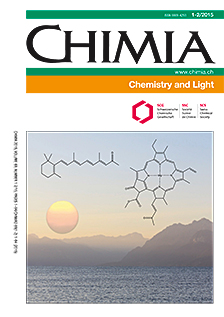Photoinduced Charge Accumulation in Molecular Systems
DOI:
https://doi.org/10.2533/chimia.2015.17Keywords:
Electron transfer, Photochemistry, Proton transfer, Solar fuel, Transient absorptionAbstract
Fuel-forming reactions such as CO2 reduction or water splitting require multiple redox equivalents. When aiming at light-driven production of energy-rich chemicals, nowadays often referred to as solar fuels, it therefore becomes important to master the photoinduced accumulation of electrons or holes on individual molecular components. Featured in this short review are some of the key molecular systems explored in this emerging field of research. This includes for example a trinuclear Ru(II)-Rh(III)-Ru(III) complex or an Ir(III)-sensitized polyoxotungstate hybrid, but also several systems in which electron or hole collection occurs at organic moieties such as perylenebis(dicarboximide), quinone-containing or oligotriarylamine-based units. In many cases the photodriven accumulation of charge requires the use of sacrificial electron donors, but there exist also a handful of studies in which redox equivalents can be accumulated without the use of such additives.Downloads
Published
2015-02-25
Issue
Section
Scientific Articles
License
Copyright (c) 2015 Swiss Chemical Society

This work is licensed under a Creative Commons Attribution-NonCommercial 4.0 International License.
How to Cite
[1]
Chimia 2015, 69, 17, DOI: 10.2533/chimia.2015.17.







